|
Home
Up
| |
~ Islands
of Pleasure ~
July 24 through August 10, 2000
$1 U.S. = 365 Greek Drachmas
(Remember to click
on the thumbnails for enlargements of the photos)
Island of Kos,
Greece
July 23 through July 31, 2000
 (ccl) One of the things that I learn again and again on this trip
is that I should never underestimate is the amount of energy that traveling
takes. I'm not talking about "traveling" in general, I'm
talking about actually, physically moving from one place to another.
Somehow, when you're making arrangements, an overnight bus ride followed
by an early morning ferry sounds like a good idea, but by the time you've
executed all of those moves, you're typically physically and emotionally
drained. By the time we arrived on the Greek island of Kos, I was
barely functioning mentally, and we were both exhausted. The spontaneity
of this trip is exhilarating 99% of the time, but there are those times
when you wish you'd get off the plane or boat and you'd see a uniformed
limo driver holding one of those write on/wipe off boards with "Mr.
and Mrs. Wiley Long" on it. This was definitely one of those
times...
(ccl) One of the things that I learn again and again on this trip
is that I should never underestimate is the amount of energy that traveling
takes. I'm not talking about "traveling" in general, I'm
talking about actually, physically moving from one place to another.
Somehow, when you're making arrangements, an overnight bus ride followed
by an early morning ferry sounds like a good idea, but by the time you've
executed all of those moves, you're typically physically and emotionally
drained. By the time we arrived on the Greek island of Kos, I was
barely functioning mentally, and we were both exhausted. The spontaneity
of this trip is exhilarating 99% of the time, but there are those times
when you wish you'd get off the plane or boat and you'd see a uniformed
limo driver holding one of those write on/wipe off boards with "Mr.
and Mrs. Wiley Long" on it. This was definitely one of those
times...
Kos is a popular package tourist
destination for travelers from northern Europe. When we walked off the
boat and into the town, we were accosted by hoards of partying Swedes and
Germans, none of them looking much older than 24, and most wearing little more
than a bikini. I quickly realized that
my Muslim-friendly attire was going to be extensively out of place
here.
A quick check a few of the hotels
recommended by our guide book told us that finding a place to stay wasn't going
to be a snap. This was something that varied wildly throughout the Greek
Isles. On some of the eight islands we visited, locals crowded the
debarkation areas at the harbors, trying to yell louder than the person beside
them in order to advertise their accommodations. On others, no one met the
boat, and we frantically
ran through the towns, attempting to beat out other tourists for the few
remaining rooms. In the Greek Isles, many
people rent extra rooms in their houses to tourists during the
summer. Usually these places, called domatia, come equipped
with kitchen facilities, and most are located close to the beaches and
nightlife. We found these places to be very comfortable and usually
spotlessly clean, and we also welcomed the chance to fix our own breakfasts and
lunches, as eating out can get pretty old after six months on the road. In
fact, many Greeks vacation this way, taking the whole month of August, traveling
to several islands by ferry, and staying in these little apartments for many
days at a time. We really liked this type of accommodation, as it gave us a
chance to kick back in a somewhat "homey" atmosphere, eat cereal for
breakfast, and even cook a few dinners in house. Not that you can do much
with the raw materials available at your average Greek mini-market, but I used
all my powers of creativity and managed to produce something that was usually
edible.
 We quickly settled into life on Kos and ended up
staying seven days there. It wasn't my favorite of all the Greek islands
we visited, but I think I've mentioned before about how inertia will overtake us and
we will stay in one place for longer than normal, simply because it's too much
trouble to go anywhere else. We rented a scooter to get around on.
Everyone on Kos seemed to have one, and it was an extremely handy way to get
around town and to explore the island. The first guy we tried to rent one
from asked Wiley for his "international motorcycle license".
When we told him that we only had international driver's licenses, he wouldn't
rent to us. So let me get this straight: all of these 22 year-old Swedish
girls who are riding around town in their string bikinis have international
motorcycle licenses??? Right... We went down the road to another
place and got set up there.
We quickly settled into life on Kos and ended up
staying seven days there. It wasn't my favorite of all the Greek islands
we visited, but I think I've mentioned before about how inertia will overtake us and
we will stay in one place for longer than normal, simply because it's too much
trouble to go anywhere else. We rented a scooter to get around on.
Everyone on Kos seemed to have one, and it was an extremely handy way to get
around town and to explore the island. The first guy we tried to rent one
from asked Wiley for his "international motorcycle license".
When we told him that we only had international driver's licenses, he wouldn't
rent to us. So let me get this straight: all of these 22 year-old Swedish
girls who are riding around town in their string bikinis have international
motorcycle licenses??? Right... We went down the road to another
place and got set up there.
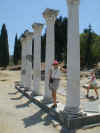 Kos was the birthplace of Hippocrates (460 - 377 B.C.), the father of medicine,
and he lived and taught throughout his life on the island. There is a
plane tree just outside the main square under which the local Chamber of
Commerce (or its Greek equivalent) claims Hippocrates taught his pupils.
Since plane trees don't usually live more than 200 years, it's doubtful that
this is much more than legend. After his death, a medical school dedicated
to Asclepius, god of healing, was built. There Greek doctors
learned their trade for well over 1000 years. As Wiley is interested in
health and longevity, one of our main purposes in visiting Kos was to see this
facility, called the Asclepion, and also to try to attend some events associated
with the Hippocratic festival. We managed to catch some folk dancing put
on by some dancers from Cyprus one night in the main square. There was
much slapping of boots and stomping of feet, and it seemed like the whole town
(the locals, not the 22 year-old Swedes) turned out to watch the
festivities.
Kos was the birthplace of Hippocrates (460 - 377 B.C.), the father of medicine,
and he lived and taught throughout his life on the island. There is a
plane tree just outside the main square under which the local Chamber of
Commerce (or its Greek equivalent) claims Hippocrates taught his pupils.
Since plane trees don't usually live more than 200 years, it's doubtful that
this is much more than legend. After his death, a medical school dedicated
to Asclepius, god of healing, was built. There Greek doctors
learned their trade for well over 1000 years. As Wiley is interested in
health and longevity, one of our main purposes in visiting Kos was to see this
facility, called the Asclepion, and also to try to attend some events associated
with the Hippocratic festival. We managed to catch some folk dancing put
on by some dancers from Cyprus one night in the main square. There was
much slapping of boots and stomping of feet, and it seemed like the whole town
(the locals, not the 22 year-old Swedes) turned out to watch the
festivities. 
On Kos we quickly settled into the
pace of Greek island life. It seems that all of Europe vacations on the
Greek Isles, and August is the high point of the season. Kos had no
shortage of bars and clubs (one of the main streets is even named "Bar
Street", just so there's no confusion about what goes on there), and the
Europeans party all night, sleep late, then spend the afternoon on the beach or
at the pool. After a few days of this hedonistic lifestyle (weren't the
Greeks the ones who made hedonism popular, after all?), I began to look at our
time in Greece as something of a demarcation in the timeline of our trip.
So far, we've been to Mexico and Peru, which were both somewhat challenging,
then to Morocco and Egypt, which were both very challenging, then to Turkey,
where we kept up a fairly frantic pace. Now, Greece, and its many
opportunities for doing nothing. A perfect chance for some R & R
before we finish up the last six months of the trip in India, Nepal, Thailand,
and Indonesia. While Greece is definitely the most expensive country we've
visited, it's nice to know that as a traveler, all of your needs can be
met. There's no hassle, no cries of "Baksheesh!", few beggars,
and a well-defined transportation infrastructure. All of these things
allowed us to relax and take it easy, perfect our tans, and prepare for the rest
of the trip. The only appointment we kept day-to-day was with the sun for
sunset.
Not to say that Greece is
perfect. There are problems for the newest member of the European Union,
like water shortages, inflation, and terrorism, to name a few. One day we took the scooter into the
interior of the island and visited several of the many picturesque villages in
the mountains of Kos. At one point we lost the thread of the main road,
and instead of finding it, we found the island's dump. Now, we all realize
that the trash we generate has to go somewhere, but somehow it's shocking
when you find a big, smelly dump in the middle of an island paradise. As I
looked around at the hundreds of plastic shopping bags that littered the
landscape, I remembered an article I had read a few months back about how the
world's population of loggerhead turtles is in imminent danger of
extinction. In fact, their numbers are so small that many environmental
groups consider them to be extinct at this point. The reason: plastic shopping bags. The turtles see a bag
floating in the water and, thinking it's a tasty jellyfish snack, gobble them
down, with often fatal consequences. So allow me to get upon my
environmental soap box for a moment and urge all of you to be aware of your
plastic bag usage. Ask for paper whenever possible, and remember to forgo
the bag when purchasing only a few items. 
We had no real agenda in the Greek
Isles, except that we wanted to visit an island recommended to us by a couple we
met in Egypt, Amorgos, and we had to be in Santorini on August 10th to meet up
with our friend from Atlanta, Paula Attaway. Getting to Amorgos wasn't the
most straightforward plan, but it allowed us to see several smaller,
less-visited islands along the way. Read on...
Island of Kalimnos,
Greece
July 31 through August 3, 2000
 If you've done any island-hopping in the Greek Isles, you know that there is an
extensive transportation network that links all 1400 of them together.
There are three types of boats which ply the waters of the Aegean and Mediterranean
seas. The slowest and most pervasive type is the standard ocean-going
ferry boat. Some are bigger than others, and the really small ones can be
tubs straight from hell on days when the seas are rough. The really big
ones hold hundreds of passengers, plus motorcycles, cars, and
tractor-trailers. Standing in the hold of a huge ferry on a hot day while
hundreds of people and vehicles prepare to debark is not an activity for the
claustrophobic. Hydrofoils are quite a bit faster than the ferries.
These boats, which scoot along on the top of the water, look like the submarine
in "20000 Leagues Under the Sea", and hold only a hundred people or so
and no vehicles. The fastest, most comfortable, and most expensive way to
travel between the islands is on the catamaran boats. They have jet
engines and they glide along on the water at quite a pace. Looking out the
windows as the boat cruises along, I was reminded of those dreams I have where I
can fly, but only about ten feet off of the ground. The insides of these
boats are slick and comfortable - you are definitely traveling in style on a
catamaran.
If you've done any island-hopping in the Greek Isles, you know that there is an
extensive transportation network that links all 1400 of them together.
There are three types of boats which ply the waters of the Aegean and Mediterranean
seas. The slowest and most pervasive type is the standard ocean-going
ferry boat. Some are bigger than others, and the really small ones can be
tubs straight from hell on days when the seas are rough. The really big
ones hold hundreds of passengers, plus motorcycles, cars, and
tractor-trailers. Standing in the hold of a huge ferry on a hot day while
hundreds of people and vehicles prepare to debark is not an activity for the
claustrophobic. Hydrofoils are quite a bit faster than the ferries.
These boats, which scoot along on the top of the water, look like the submarine
in "20000 Leagues Under the Sea", and hold only a hundred people or so
and no vehicles. The fastest, most comfortable, and most expensive way to
travel between the islands is on the catamaran boats. They have jet
engines and they glide along on the water at quite a pace. Looking out the
windows as the boat cruises along, I was reminded of those dreams I have where I
can fly, but only about ten feet off of the ground. The insides of these
boats are slick and comfortable - you are definitely traveling in style on a
catamaran.
There are twenty or thirty companies
who run these boats between the islands, and it seems that the travel agents on
each island only know the schedules for the boats coming to and going from their
island. This makes planning a bit difficult, but you have got to figure,
what's the worst thing that can happen if I don't make the right hop at the
right time? So I get stuck on one island, which is paradise, and can't get
to another island, which is also paradise, on the exact day that I
planned? You get all this in perspective, and you start to relax about
traveling between the islands.
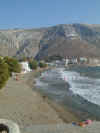 Our only real reason for going to Kalimnos was to catch a subsequent boat to
Astypalea, because we believed that was the best way to get to Amorgos.
When we arrived on Kalimnos via the hydrofoil on that Monday morning, we only
planned to stay one night, and leave on the following night at 7:30 for
Astypalea. We filled our day and a half on Kalimnos by exploring the port
town and sunning ourselves on the beach. The beaches on Kalimnos were some
of the best we saw in the Greek Isles, and the towns in the islands look just
like all of the pictures you've seen of Greece. White-washed houses, blue
doors and shutters, and breathtakingly beautiful profusions of bougainvilla and
geraniums, all set against a crystal clear azure-blue sky. Getting lost in
one of these little villages is pretty much impossible, and you're almost
guaranteed to meet a friend and strike up a conversation along the way.
Our only real reason for going to Kalimnos was to catch a subsequent boat to
Astypalea, because we believed that was the best way to get to Amorgos.
When we arrived on Kalimnos via the hydrofoil on that Monday morning, we only
planned to stay one night, and leave on the following night at 7:30 for
Astypalea. We filled our day and a half on Kalimnos by exploring the port
town and sunning ourselves on the beach. The beaches on Kalimnos were some
of the best we saw in the Greek Isles, and the towns in the islands look just
like all of the pictures you've seen of Greece. White-washed houses, blue
doors and shutters, and breathtakingly beautiful profusions of bougainvilla and
geraniums, all set against a crystal clear azure-blue sky. Getting lost in
one of these little villages is pretty much impossible, and you're almost
guaranteed to meet a friend and strike up a conversation along the way. 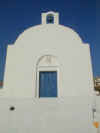
After waiting for our ferry for over
an hour, it finally arrived, bringing the news that it would not be continuing
on to Astypalea that evening, as the seas were too rough. The next boat
was in two days at 7:00 AM, so we re-shouldered our backpacks and found another
two nights accommodation at a domatia on the other side of the island.
Although this setback gave us only two days on Amorgos ultimately, we really
enjoyed our time on Kalimnos. Our new place looked right down the cliffs
at the ocean, and we spent the time getting in a workout and lounging on the
beach. One day, we were looking for a shady spot to eat our lunch outside
our room. The only spot was a somewhat cramped place on the steps leading
down to the town, and when a local woman spotted us sitting there, she invited
us into her garden to a seat at her table. She spoke no English and we
spoke no Greek, but we communicated with a series of smiles and nods. She
brought us pears from her tree and eggs from her chickens.
Island of
Astypalea, Greece
August 3 through August 6, 2000
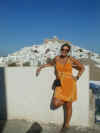 We finally got on our way to Astypalea, and a few minutes into the boat ride I
began to understand why it might not have been a good idea for her to sail in
rough seas. I snagged a bench in the snack bar and slept for the three
hour ride. By 10:30 we were in Astypalea, and on the hunt for a
room. The first four or five places we checked were full, which always
makes me nervous. August is a big vacation month in Europe. I have
heard that Paris and Rome are virtually empty during that time, and apparently
this is also when all the Greeks leave Athens and come to the islands. I
always wonder - how can they all go on vacation at the same time? Who
answers the phone in the offices? Anyways, this was contributing to our
struggles with securing a room, but we finally found a nice domatia with a three
night minimum stay required. Perfect - the next boat for Amorgos was in
three days.
We finally got on our way to Astypalea, and a few minutes into the boat ride I
began to understand why it might not have been a good idea for her to sail in
rough seas. I snagged a bench in the snack bar and slept for the three
hour ride. By 10:30 we were in Astypalea, and on the hunt for a
room. The first four or five places we checked were full, which always
makes me nervous. August is a big vacation month in Europe. I have
heard that Paris and Rome are virtually empty during that time, and apparently
this is also when all the Greeks leave Athens and come to the islands. I
always wonder - how can they all go on vacation at the same time? Who
answers the phone in the offices? Anyways, this was contributing to our
struggles with securing a room, but we finally found a nice domatia with a three
night minimum stay required. Perfect - the next boat for Amorgos was in
three days.
Astypalea is a quiet island, which
explains its popularity with the Greeks. There may be discos here, but we
never saw them. Most people spend the day on the beach with their
families, playing in the water, then sit in small restaurants at night, eating
local specialties like grilled octopus and drinking the national drink of
Greece, Ouzo. We did no real sight-seeing on Astypalea - basically just
walked to the beach every day, napped in the late afternoons, and cooked dinner
in or ate seafood out. I had my first octopus on Astypalea, and I'm pretty
sure I'm done with it. They serve the tentacles grilled over a charcoal
fire, and while the flavor is pretty good, the texture is somewhat chewy, and
the suction cups are right there, staring you in the face, which is somewhat
disconcerting. 
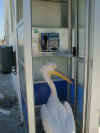 On Sunday we finally caught the ferry to Amorgos, but not before meeting the
island's unofficial mascot at the port, a large pelican. He entertained
many travelers that day by doing things like taking their arms (gently) in his
bill and walking with them up the gangplank of the ship, but few people were
around when we got this shot of him entering a phone booth, presumably to call a
close friend on another island and ask how the fishing was there.
On Sunday we finally caught the ferry to Amorgos, but not before meeting the
island's unofficial mascot at the port, a large pelican. He entertained
many travelers that day by doing things like taking their arms (gently) in his
bill and walking with them up the gangplank of the ship, but few people were
around when we got this shot of him entering a phone booth, presumably to call a
close friend on another island and ask how the fishing was there.
Island of Amorgos,
Greece
August 6 through August 8, 2000
 Finally, Amorgos - the island we had been trying to reach for almost a
week. As the ferry pulled into the little harbor and docked, we knew that
we were going to like it. Interesting music, nice restaurants and bars, a
small town square with a huge, spreading shade tree, and a lovely beach.
We debarked, and headed towards two hotels we had seen from the ferry. At
both of them, we were told, "full". No worries. We'd hit
this snag before, and knew we'd eventually find something. We walked into
town and began asking at each of the places we came upon that displayed the sign
"Rooms to Let". Everywhere we asked, we heard the same answer -
"full". After several minutes of this, we began to pass the same
travelers again and again, all in the same predicament as us. Figuring we
could cover more ground without the packs, Wiley sat down and guarded the gear
while I scampered around town, trying to beat out the other tourists in what had
now become a competition. I ran into the Hotel Minoan on the main square,
figuring it was a long shot - but there were rooms. We settled in, and
later ran into some German travelers Wiley had met earlier in the day.
After two hours, they still hadn't found accommodations, and they had camping
gear with them, so even the campgrounds were full. This traveling by the
seat-of-the-pants is not for the faint-hearted.
Finally, Amorgos - the island we had been trying to reach for almost a
week. As the ferry pulled into the little harbor and docked, we knew that
we were going to like it. Interesting music, nice restaurants and bars, a
small town square with a huge, spreading shade tree, and a lovely beach.
We debarked, and headed towards two hotels we had seen from the ferry. At
both of them, we were told, "full". No worries. We'd hit
this snag before, and knew we'd eventually find something. We walked into
town and began asking at each of the places we came upon that displayed the sign
"Rooms to Let". Everywhere we asked, we heard the same answer -
"full". After several minutes of this, we began to pass the same
travelers again and again, all in the same predicament as us. Figuring we
could cover more ground without the packs, Wiley sat down and guarded the gear
while I scampered around town, trying to beat out the other tourists in what had
now become a competition. I ran into the Hotel Minoan on the main square,
figuring it was a long shot - but there were rooms. We settled in, and
later ran into some German travelers Wiley had met earlier in the day.
After two hours, they still hadn't found accommodations, and they had camping
gear with them, so even the campgrounds were full. This traveling by the
seat-of-the-pants is not for the faint-hearted.
Our plan was to be on Santorini a
couple of days before Paula arrived, in order to check things out and find a
good place where all of us could stay. That left us only one full day on
Amorgos, and we made the most of it. We rented a scooter again and spent
the day exploring the island. Our first stop was the island's most prized
tourist destination - the Moni Hozaviotissis. This Greek Orthodox
monastery clings precipitously to the side of a cliff on a windswept, rocky
stretch of the island. Monks still inhabit the place, although only a few.
Greek Orthodox is the official state
religion of Greece, and 98% of the population claims it as their faith.
Founded in the 4th century by Constantine the Great, it is the third largest
sect of Christianity, and its traditions and ceremonies are inseparably
intertwined with Greek life. On any visit to Greece, you will see older
women clad solely in black clothing. These women are mourning a death,
most likely their husband's, as Greek women are typically much younger than the
men they marry. Greek Orthodox doctrine dictates that a woman must mourn
her husband's death for five years. During that time she must wear only
black, must visit his grave daily, and cannot see other men or have any real
social life except interaction with family. For men, as you might imagine,
the rules are different. A man must mourn the passing of his wife for only
forty days, after which time he can get right back out there in the dating
world. We observed people all around the Greek Isles genuflecting as they
passed a cemetery, no doubt paying their respects in silence to loved ones who
rested there.
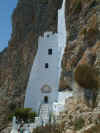 Built in the 11th century, Moni Hozoviotissis
contains a miracle-working icon that supposedly arrived un-aided from
Jerusalem by sea on the rocks below the monastery. Once we arrived
there, it dawned on us that we weren't dressed appropriately, as I had
on a bathing suit and a sarong and Wiley was wearing shorts. We
decided to climb up to the building itself, as much to see it from the
outside as to gaze upon the jewel-like waters of the Aegean crashing on
the rocks below. The climb up to the monastery took about 15 minutes,
and followed a rocky stairway build right into the cliff side. At
the top, I realized that if I put on Wiley's t-shirt and made my sarong
longer, I could go inside. So we had a little clothes exchange outside
on the rocks and in a few minutes I was inside. The monk inside
the doorway greeted me, and at that point I saw that he administered a
whole line of fashions, reserved specifically for improperly-dressed tourists.
Built in the 11th century, Moni Hozoviotissis
contains a miracle-working icon that supposedly arrived un-aided from
Jerusalem by sea on the rocks below the monastery. Once we arrived
there, it dawned on us that we weren't dressed appropriately, as I had
on a bathing suit and a sarong and Wiley was wearing shorts. We
decided to climb up to the building itself, as much to see it from the
outside as to gaze upon the jewel-like waters of the Aegean crashing on
the rocks below. The climb up to the monastery took about 15 minutes,
and followed a rocky stairway build right into the cliff side. At
the top, I realized that if I put on Wiley's t-shirt and made my sarong
longer, I could go inside. So we had a little clothes exchange outside
on the rocks and in a few minutes I was inside. The monk inside
the doorway greeted me, and at that point I saw that he administered a
whole line of fashions, reserved specifically for improperly-dressed tourists.
 The inside of the monastery was remarkable. The passageways and
stairways followed the natural rock formations of the cliffs, and the
whole place was white-washed silence. At the top of several flights
of stairs, there was a small, ornate chapel. Greek Orthodox churches
are quite elaborate inside, and contain much silver and many rich paintings
of important saints. Outside the chapel I was led into a small museum,
where I was offered candy that resembled Turkish
Delight by a young monk. Another young monk then came by with
a tray containing large glasses of water and smaller, shot-sized glasses
of a pale golden substance. I took one of each, and asked what was
in the smaller glass. In broken English he told me that grapes were
boiled with water to make it, and one sip told me that it was some type
of brandy. Interesting hospitality for a monastery, and at 11:30
in the morning! Wiley went in after I came out, after being fitted
with a particularly attractive pair of baggy pants that were too short
and had no waistband.
The inside of the monastery was remarkable. The passageways and
stairways followed the natural rock formations of the cliffs, and the
whole place was white-washed silence. At the top of several flights
of stairs, there was a small, ornate chapel. Greek Orthodox churches
are quite elaborate inside, and contain much silver and many rich paintings
of important saints. Outside the chapel I was led into a small museum,
where I was offered candy that resembled Turkish
Delight by a young monk. Another young monk then came by with
a tray containing large glasses of water and smaller, shot-sized glasses
of a pale golden substance. I took one of each, and asked what was
in the smaller glass. In broken English he told me that grapes were
boiled with water to make it, and one sip told me that it was some type
of brandy. Interesting hospitality for a monastery, and at 11:30
in the morning! Wiley went in after I came out, after being fitted
with a particularly attractive pair of baggy pants that were too short
and had no waistband.
 Our last night on Amorgos we tried to take it easy by
eating dinner early and going to bed, as we had a 6:00 AM ferry in the morning,
but nightlife on the Greek Isles evolves slowly, and we found ourselves caught
up in that as we sat down to pizza at midnight. The next morning we were
up, bleary-eyed, and on the ferry at the appointed time. Our plan for the
day took us by small ferry to the island of Naxos, where we would then catch
another boat to the famed island of Santorini, where we were set to host the
first special guest star of the Long's Strange Trip.
Our last night on Amorgos we tried to take it easy by
eating dinner early and going to bed, as we had a 6:00 AM ferry in the morning,
but nightlife on the Greek Isles evolves slowly, and we found ourselves caught
up in that as we sat down to pizza at midnight. The next morning we were
up, bleary-eyed, and on the ferry at the appointed time. Our plan for the
day took us by small ferry to the island of Naxos, where we would then catch
another boat to the famed island of Santorini, where we were set to host the
first special guest star of the Long's Strange Trip.
Click
here to continue in Greece with "No One is an Island"
|
